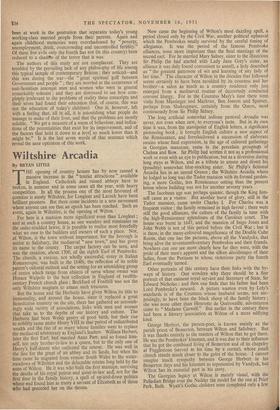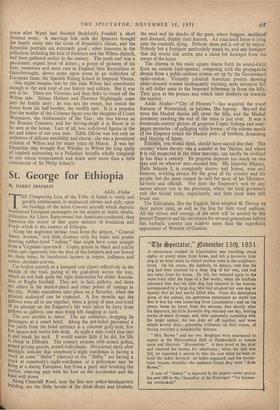Wiltshire Arcadia
By BRYAN LITTLE
THE opening of country houses has by now caused a massive increase in the "tourist attractions" available in England. Cathedrals and ruined abbeys have to reckon, in summer and in some cases all the year, with heavy competition. In all the process one of the most favoured of counties is surely Wiltshire, for Longleat and Lacock have been brilliant pioneers. But there come incidents in a new movement - where anyone can see that an epoch has been reached. Such an event, again in Wiltshire, is the opening of Wilton. - For here is a mansion more significant even than Longleat ; and at such a country house, as one wanders and ruminates on the cedar-studded lawns, it is possible to realise most forcefully what we owe to the builders and owners of such a place. Nor, at Wilton, is the town without importance, for the borough is senior to Salisbury, the mediaeval "new town," and has given its name to the county. The carpet factory can be seen, and was the creation, about 1700, of the eighth Earl of Pembroke. The church, a curious, not wholly successful, essay in Italian Romanesque, was built in the 1840s, the reflection of its noble patron's cultural outlook and the setting for an astonishing group of curios which range from objects of vertu whose owner was Horace Walpole to the best collection in England of twelfth- century French church glass ; Beckford of Fonthill was not the only Wiltshire magnate to amass such treasures.
But the house and the Herberts have given Wilton its title to immortality, and around the house, since it replaced a great Benedictine nunnery on the site, there has gathered an astonish- ingly wide variety of associations, links with men and women that take us to the depths of our history and culture. The Herberts had been Welsh gentry of good birth, but their rise to nobility came under Henry VIII in that period of redistributed wealth and the rise of so many whose families were to replace the mediaeval aristocracy as England's leaders. William Herbert, later the first Earl, had married Anne Parr, and so found him- self, not only brother-in-law to a queen, but to the only one of Henry's half-dozen who outlasted the course. He was well in the line for the grant of an abbey and its lands, but when his time came he migrated from remote South Wales to the water- meadows of Wiltshire and the delectable estates long held by the nuns of Wilton. He it was who built the first mansi9n, surviving the deaths of his royal patron and sister-in-law and, not for the first time in the family history, a spell of up-and-down politics whose end found him as trusty a servant of Elizabeth as of those who had preceded her on the throne. Now came the beginning of Wilton's most dazzling spell, a period closed only by the Civil War, another political upheaval which the Pembrokes neatly survived by the careful timing of allegiance. It was the period of the famous Pembroke alliances, none more important than the final marriage of the second earl. For he married Mary Sidney, sister to the illustrious Sir Philip (he had started with Lady Jane Grey's sister, an alliance it was duly found convenient to annul), a lady described as "the greatest patroness of wit and learning of any lady of her time.' The character of Wilton 'in the decades that followed seems certainly to have been moulded by its countess and her brother—a salon as much as a country residence only just emerged from a mediaeval routine of decorously conducted convent liturgy. For in the Countess Mary's time there were visits from Massinger and Marlowe, Ben Jonson and Spenser, perhaps from Shakespeare, certainly from the Queen, most continuously from Sir Philip Sidney.
The long artificial somewhat tedious pastoral Arcadia was never, not even when new, to everyone's taste. But in its own time it was, from the standpoint of English letters, a significant pioneering book ; it brought English culture a new aspect of the Renaissance, and foreshadowed a succession of elaborate swains whose final expression, in the age of cultured gatherings in Georgian mansions, came in the porcelain groupings of Chelsea and Bow. Sir Philip had written it not as a professional work or even with an eye to publication, but as a diversion during long stays at Wilton, and as a tribute to amuse and divert his (possibly) somewhat blue-stocking sister. Sir Philip's fictional Arcadia lies in an unreal Greece ; the Wiltshire Arcadia where he lodged so long was the Tudor mansion with its formal garden- ing, a more Gothic, less Renaissance setting than the present house whose building was not for another seventy years.
The Jacobean age was perhaps quieter, though the King him- self came as a visitor. But another burst of glory, still in the Tudor mansion, came under Charles I. .For Charles was a frequent visitor ; the family remained in high favour ; there were still the good alliances, the culture of the family in tune with the high-Renaissance splendours of the Carolean court. The house was burnt in 1647, and the mansion of Inigo Jones and John Webb is not of this period before the Civil War ; but it is there, in the many-coloured magnificence of the Double Cube Room, that one has the pictures, above all the Vandycks, that bring alive the seventeenth-century Pembrokes and their friends.
Nowhere can one see more clearly how far they were, with the pride of their men's apparel and the silken decolletages of their ladies, from the Puritans to whose victorious party the fourth Earl eventually turned.
Other portraits of this century have their links with the by- ways of history. One wonders why there should be a fine portrait of that eminent royal servant and Secretary of State, Sir Edward Nicholas ; and then one finds that his father had been Lord Pembroke's steward. A picture wanton even by Lely's standards is of the Countess whose husband seems, not sur- prisingly, to have been the black sheep of the family history ; she was none other than Henriette de Querouaille, adventuress sister to "Madame carwell." But earlier in the century there had been a literary association at Wilton of a more edifying kind.
George Herbert, the parson-poet, is known mainly as the parish priest of Bemerton, between Wilton and Salisbury. But it was thanks entirely to the masters of Wilton that he got there. He was the Pembrokes' kinsman, and it was due to their influence that he got the combined living of Bemerton and of its chapelry at Fugglestone (served in his time by a curate), whose small church stands much closer to the gates of the house. I cannot imagine much sympathy between George Herbert in his Bemerton days and his kinsmen as represented by Vandyck, but Wilton has its essential part in his story.
The Georgian legacy at Wilton is mainly visual, with the Palladian Bridge over the Nadder the model for the one at Prior Park, Bath. Wyatt's Gothic cloisters were completed only a few years after Wyatt had finished Beckford's Fonthill a short distance away. A marriage link with the Spencers brought the family easily into the circle of Reynolds's clients, and the Reynolds portraits are extremely good ; other treasures in the collection, including the best of furniture and the Wilton diptych, had been gathered earlier in the century. The tenth earl was a passionate, expert lover of horses ; a group of pictures of his time, numerous and more rare in England than Reynoldses or Gainsboroughs, shows scene upon scene in an institution of European fame, the Spanish Riding School in Imperial Vienna. One might imagine that by this time Wilton had contributed enough to the sum total of our history and culture. But it was not to be. There are Victorian and later links to round off the Wilton tale. Sidney Herbert and Florence Nightingale come into the family story ; he was not the owner, but rented the house from his half-brother, the twelfth earl. It is a paradox that the mother of this Crimean figure was the daughter of Count • Woronzow, the Ambassador of the Tsar ; she was known as the Russian Countess, and her driving-sleigh a /a Russe is to be seen at the house. Last of all, two well-loved figures in the art and letters of our own time. Edith Olivier was not only an authoress of delicate sensibility and charm ; she was a prominent resident of Wilton and for many years its Mayor. It was her friendship that brought Rex Whistler to Wilton for long spells of inspired sojourning, to a Palladian Arcadia wholly congenial to one whose temperament and death were more than a little reminiscent of Sir Philip Sidney's.















































































 Previous page
Previous page